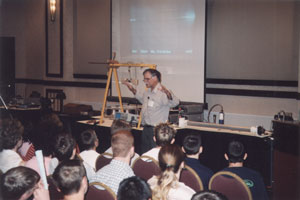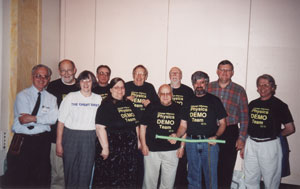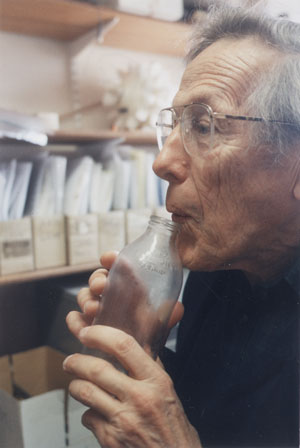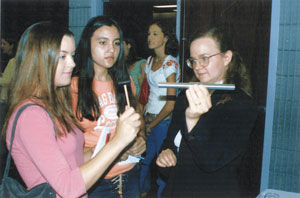The Acoustical Society of America, one of 12 member societies in the American Institute of Physics, was founded in 1929 at the Bell Telephone Laboratories in New York City. Its 7000 members represent all fields of acoustics. It holds general meetings every spring and fall, and it recently celebrated its 75th anniversary by meeting in New York, where it was founded. From its beginning the ASA has had strong ties with education. Sessions on Acoustics Education The Committee on Education in Acoustics arranges special sessions on acoustics education at nearly every meeting of the Society. Often these sessions are co-sponsored by one of the technical committees (co-sponsorship by musical acoustics and architectural acoustics appear to have been the most common). These sessions have focussed on a wide range of activities in acoustics education. We mention examples of a few of these. Laboratory experiments in acoustics. Science is best taught (and learned) by hands-on experience. “I hear, I forget. I see, I remember. I do, I understand.” Laboratory instruction has always been an important part of physics teaching, and the teaching of acoustics is certainly no exception. The Committee on Education in Acoustics has arranged several successful sessions at ASA meetings on laboratory experiments in acoustics. For example, a session in 1985 featured personal computers for laboratory instruction, while a session in 1987 focussed on project laboratories. Sessions in 1993 and 1999 dealt with undergraduate laboratory experiments in acoustics, while a session in 2001 looked at low-cost laboratory experiments. Demonstration experiments in acoustics. Demonstration experiments rank next to hands-on laboratory experience as effective ways to learn acoustics and vibrational physics. From the time of Pythagoras, demonstration experiments have been used to demonstrate acoustical phenomena. Faraday and Helmholtz and Rayleigh and Tyndall were famous demonstrators. Sessions on demonstration experiments in acoustics often draw standing-room-only crowds.  |  | | Session on acoustics demonstration experiments at an ASA meeting | Styrofoam balls levitated in a sound field |
At the 141st meeting in Chicago (2001), Tom Rossing and Uwe Hansen presented a tutorial lecture on Demonstration Experiments in Acoustics, at which a group of Chicago-area physics teachers joined ASA regulars in doing acoustics demonstration experiments in rapid succession. 
| Chicago-area physics teachers participate in an ASA tutorial on demonstration experiments in acoustics |
Take-Fives At these sessions, which have become very popular, participants present short demonstration experiments, videos, or innovative ideas for teaching acoustics. The term “take-fives,” borrowed from physics teacher meetings, refers to the 5-minute time limit imposed on the speakers in order to maintain the pace of the session. The popularity of take-five sessions results partly from their spontaneity, and most attendees agree that they return home with new teaching ideas as well as enthusiasm to try them out. 
| Milk bottle from Rayleigh dairy |
ASA reaches out to high school students Outreach to high school students has become an important activity of the Acoustical Society of America. Special sessions for high school students are now frequently scheduled at ASA meetings. Sometimes they are sessions at which acoustics demonstration experiments of particular interest to high school students are presented (although these sessions are well attended by ASA members as well!). Sometimes they involve hands-on experiments that high school students can perform with advice from ASA members acting as docents. Since ASA meetings are often held in large cities, it has been particularly effective to invite students from inner city high schools with large numbers of minority students. Special effort has been made to have female and minority members of ASA as docents. Sometimes a pizza lunch is provided by ASA. At some future date, we hope to hear a testimonial from an acoustician whose first contact with acoustics came by visiting such a session at an ASA meeting.  |  | | High school students observe longitudinal waves in a rod | High school students observe Chladni figures |
In addition to inviting high school students to hands-on sessions, we have taken demonstrations into high school classrooms. These class visits usually take the form of an introductory acoustics lesson with numerous demonstrations designed to augment regular physics curricula. Principles frequently demonstrated include resonances on stretched strings and in air columns, normal mode vibrations on plates illustrated with Chladni patterns, and spectral analysis and synthesis. One such visit was conducted during the 147th ASA meeting in May 2004 in New York in the context of the 75th Anniversary celebration with a very successful visit to a science class of the Professional Performing Arts School in Manhattan. Workshops for teachersThe ASA Technical Committee on Musical Acoustics (TCMA) has sponsored a series of workshops for high school teachers and for elementary school teachers. Support has come from the Department of Education by way of “Eisenhower” grants as well as from ASA in the form of technical initiatives. Uwe Hansen and other members of TCMA have organized these very successful workshops. Emphasis at the high school teacher workshops is on construction of inexpensive equipment for doing laboratory and demonstration experiments on sound. For example, teachers build their own monochords and air column resonators, using pre-cut lumber, do experiments with this equipment, and take it home for use in their own classes. In one workshop, the teachers used computer-based data acquisition systems to do spectral analysis of sound. Some of these workshops have been held in conjunction with ASA meetings, some at universities (University of Maryland, University of Houston, Brigham Young University, and Indiana State University), and some in local school districts. The workshops for elementary grade and middle school teachers have emphasized using music as a vehicle to introduce science concepts in the classroom. Basic acoustical principles are presented, followed by a session on practical classroom applications using tools given to the teachers to take back to their schools. The tools have included a spring and slinky for wave demonstrations, a monochord to relate the harmonic series to audible tones, an air column resonance device, a self-resonant tuning for, and a corrugated whirling tube resonator. Workshop venues have included ASA meetings, state science teacher conventions, local school districts, and universities. Over a dozen of such workshops have been held over the last ten years. ECHOES One of the authors (TDR) edits ECHOES, a quarterly newsletter, for the ASA. ECHOES aims to keep ASA members informed about acoustics news, but it also reaches out to students and to the general public. ECHOES is sent to schools and teachers that request it, and it is also available online at http://asa.aip.org/echoes.html. Thermoacoustics and sonoluminescence Two interesting acoustical phenomena that have been in the news recently are thermoacoustics and sonoluminescence. Thermoacoustics deals with the conversion of heat to sound and vice versa. Thermoacoustic engines and refrigerators use acoustical components and networks to produce mechanical power or to pump heat, or both, without the use of traditional mechanical contrivances such as pistons, linkages, and valves. Thermoacoustic refrigerators have been developed for NASA to use in space and for Ben & Jerry’s to freeze ice cream in an environmentally friendly way. In the Summer 2000 issue of ECHOES, Penn State physicists Steven Garrett and Reh-lin Chen described a simple thermoacoustic engine kit, easily constructed by high school students that would use heat to generate sound. How many of these “acoustic lasers,” as they called their device have been built in high school science classes is anyone’s guess. At the moment, no thermoacoustic ice cream freezer kits are available. Sonoluminescence is the conversion of sound into light. It is a mysterious process in which sound waves aimed at a container of liquid nucleate, grow, and collapse gas-filled bubbles to create ultrashort light flashes. The violent collapse of the bubbles is associated with temperatures that momentarily exceed those of the sun. According to a report in Science in 2002, scientists at the Oak Ridge National Laboratory saw evidence of nuclear fusion in a small cylinder of deuterated acetone by means of sonoluminescence. A physics apparatus company (TeachSpin) now sells a sonoluminescence apparatus for use in student physics laboratories. Audio and video materials The ASA co-sponsored (with the Institute for Perception Research and Northern Illinois University) production of a Compact Disc with 39 auditory demonstrations designed for teaching the science of hearing and perception. This CD is widely used in the teaching of musical acoustics (physics of music), hearing, and perception. ASA also has produced several videotapes for teaching speech acoustics. A three-tape set on speech production includes demonstrations of use of MRI, ultrasound, and velotrace in speech acoustics. A video on Speech Perception includes demonstrations of spoken language processing, phonetic interpretation, developmental speech perception, and cross-modal speech recognition. Thomas Rossing is Professor Emeritus of Physics at Northern Illinois University. He is a Fellow of ASA as well as APS and edits the fall issue of the Forum on Education newsletter. Uwe Hansen is Professor Emeritus of Physics at Indiana State University. He is a Fellow of ASA and chairs its Committee on Education in Acoustics. |